Category: Air National Guard
Idaho National Guard demonstrates joint capabilities to governor
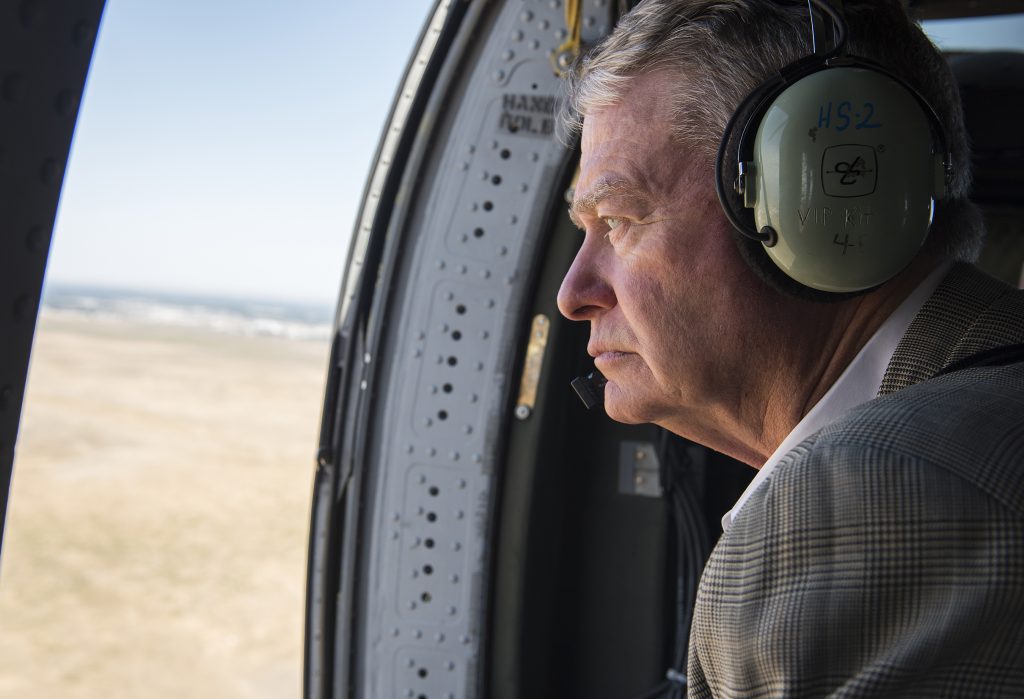
Story by Master Sgt. Becky Vanshur
124th Fighter Wing
Idaho Gov. Brad Little met with several key military leaders Aug. 19 at the Orchard Combat Training Center to receive an update on current Idaho National Guard programs and major upcoming events and exercises.
“It is critical that the governor, in his role as the commander in chief of the Idaho National Guard, takes the time to see the capabilities of our Soldiers and Airmen,” said Maj. Gen. Michael Garshak, adjutant general of Idaho. “It allows him to fully understand, firsthand, the issues that are relevant to our readiness.”
Senior leaders briefed the governor on unit training missions and deployment rotations, the F-35A Lighting II Environmental Impact Study, Idaho’s State Partnership Program with Cambodia, the Idaho Youth ChalleNGe Academy dormitory project, A-10 Thunderbolt II modernization efforts, and current and future issues facing the Orchard Combat Training Center.
The OCTC plays a large role in the readiness and training of Idaho Army National Guard Soldiers and Idaho Air National Guard Airmen. During the governor’s visit, the Idaho National Guard highlighted the ways it ensures good environmental stewardship to protect and preserve the National Conservation Area of the OCTC, which includes the OCTC Fire Department’s quick response times.
“Our fire department has an extremely quick response time – less than two minutes,” said Lt. Col. Chris Borders, Idaho National Guard public affairs officer. “In return, we also have the smallest average number of acres burned in the NCA and a high concentrated area of native vegetation and monitored wildlife, due to our fire department and the Idaho National Guard biologists working to preserve this area.”
During a tour of the OCTC, Tactical Air Control Party Master Sgt. Douglas Brock from the 124th Air Support Operations Squadron called in air strike locations to A-10 Thunderbolt II pilots above to emphasize the capabilities of close air support with ground forces, similar to a deployed environment. This also highlighted to the key leaders the joint relationship between the Army and the Air National Guard working together in a combat situation.
“We are extremely fortunate here in Idaho to have Gov. Little embrace his duties as commander in chief and fully support the men and women of the Idaho National Guard,” said Garshak.
Back to Newsroom
Join the Idaho Air National Guard
Children of National Guardsmen “survived” summer camp
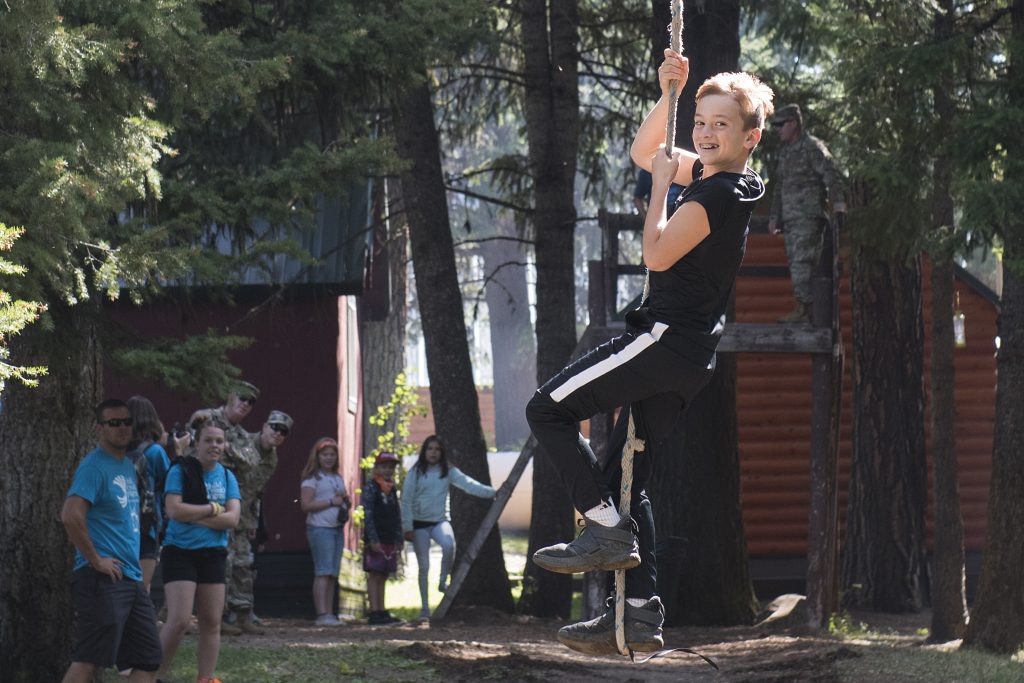
Story by Master Sgt. Becky Vanshur
124th Fighter Wing
McCall, IDAHO – After a week away from their parents, 115 children of Idaho Army and Air National Guardsmen not only survived the “Survivor”-themed summer camp, they thrived. The event-filled camp was held Aug 12-16 and was designed to build resiliency and strength in youth of military families.
“This camp is a small token of our appreciation for these children,” said Brig. Gen. Farin Schwartz, assistant adjutant general-Army, Idaho Army National Guard. “We realize that we impact the lives of the youth and appreciate the sacrifice of each and every one of these children, and what they do to support their mom or dad when they are away.”
Idaho National Guard Child and Youth Programs invite children from families in the Idaho National Guard to a winter camp and a summer camp each year. This year’s summer camp theme was “Survivor – Camp vs. The Camper” held at Quaker Hill Camp in McCall.
Activities included archery games, art classes, creative STEM challenges, inner reflection classes, lakeside water activities, a peer pressure and stress management class, a ropes team-building course, team-building races, and a zip line confidence-building course.
“All activities here are fun, but they are based on strength and resiliency training,” said Lt. Col. Douglas Uphoff, IDNG family program director. “The parents of these children could be at risk for a deployment at any time. We are enabling the children to hopefully cope with the stress of their loved ones leaving.”
Older children had the opportunity to volunteer as teen leaders. The child and youth programs are designed with opportunities for youth to gain leadership skills, feel valued, and interact with their peers.
“I love this camp, I have made a lot of friends,” said Gabbie Barton, a participating child at the camp. “I have learned that I am strong.”
Many of these military children shared common experiences with each other during the activities and know each other from past events.
“This camp has been so fun and I learned a lot,” said Lillyan Lowery, whose mother serves in the Idaho Army National Guard. “I have made all of these new friends that I can hang out with after, like her, both of our moms are in the Army together.”
It doesn’t matter how long the deployment is, the goal is for campers to build networks including other children with a similar background. Children at the camp know that their newly bonded friends are also going through the same situation and might have similar issues.
“It’s not easy for children and spouses to have us be in the military,” said Schwartz. “But it is very necessary for us to go out and do what is needed in the defense of our nation.”
Employers had outreach opportunities with the two-day ESGR Boss Lift
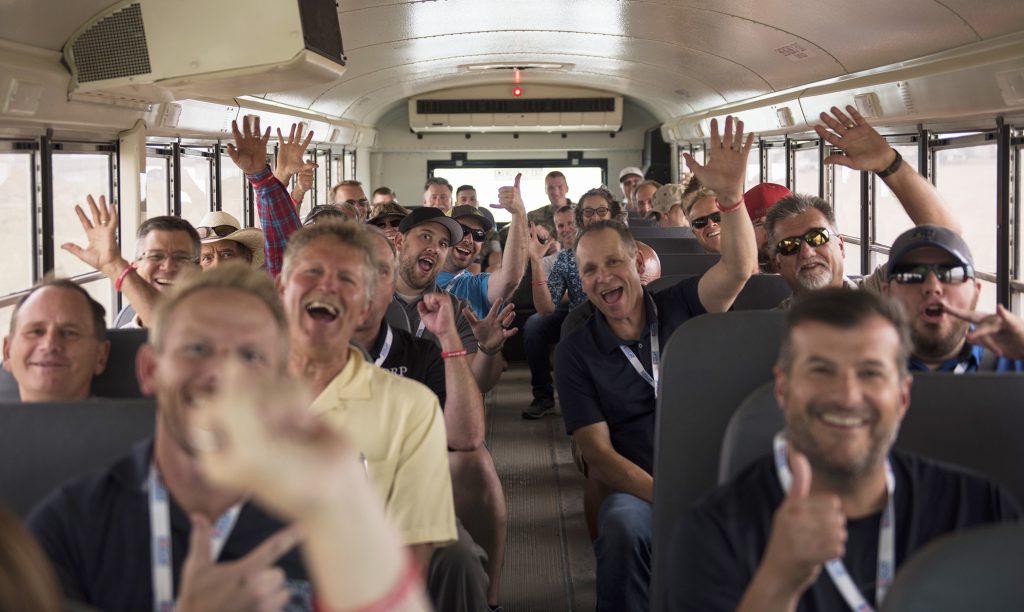
IDAHO ARMY NATIONAL GUARD, UNITED STATES
Story by 2Lt. Crystal Farris
More than 100 National Guard and Reserve employers and supervisors traveled to Gowen Field from across the state today to participate in the Idaho ESGR’s annual Boss Lift.
The two-day event gives participants a first-hand look into what their Soldiers, Marines and Airmen do away from work approximately 36 days of the year for military training.
“We enjoy tremendous support from our employers and the ESGR throughout Idaho and we do not take that for granted,” said Maj. Gen. Michael Garshak, adjutant general of Idaho. “Boss Lift is a great opportunity to create awareness of our missions in the Idaho National Guard and Reserves and to express our appreciation to those employers and the community who contribute to our mission readiness.”
ESGR aims to promote, recognize and develop employer support for Guard and Reserve service through employer outreach opportunities. As part of Boss Lift, Citizen-Soldiers, Marines and Airmen invited their employers to walk a day in their boots touring various training simulators, Gowen Field and Orchard Combat Training Center facilities and ranges, aircraft and other military hardware used by the Idaho National Guard and Reserve units for training. Additionally, Idaho Army National Guard, US Army, Marine Reserve and Idaho Air National Guard representatives were available to answer questions from employers on machinery and provide insight into the life of a military member.
Wendy Lovitt, who supervises Airman Melynda Scheller in her nursing job at Saint Alphonsus Regional Medical Center in Boise, said Scheller was really excited to invite her to Boss Lift.
“Melynda really wanted me to come so I could see everything that goes on in her Guard life,” said Lovitt. “See felt like my seeing it and being around it all would better help me understand things then if she were to explain them herself. I definitely feel more connected to her lifestyle after today.”
Training simulators offered employers a fun look into how service members develop tactical and technical skills in combat operations from a controlled in-door environment. The tour included the 124th Fighter Wing’s A-10 Thunderbolt II and the Idaho Army National Guard’s M4 rifle and HMMWV simulators.
The Idaho Army National Guard’s 1st Battalion of the 183rd Assault Helicopter Battalion flew employers in UH-60 Black Hawks over the vast terrain and world-class military ranges of the Orchard Combat Training Center. For some passengers, it was their first time in a helicopter and for others it offered insight into the austere conditions service members train in throughout the year.
“It is important for employers to understand what their service members do when fulfilling their military commitments,” said Cindy Reese, ESGR state chair. “This event gives them the opportunity to see what their employees do in these times, how they do it and why.”
Brig. Gen. Nolan retires after nearly 35 years of service
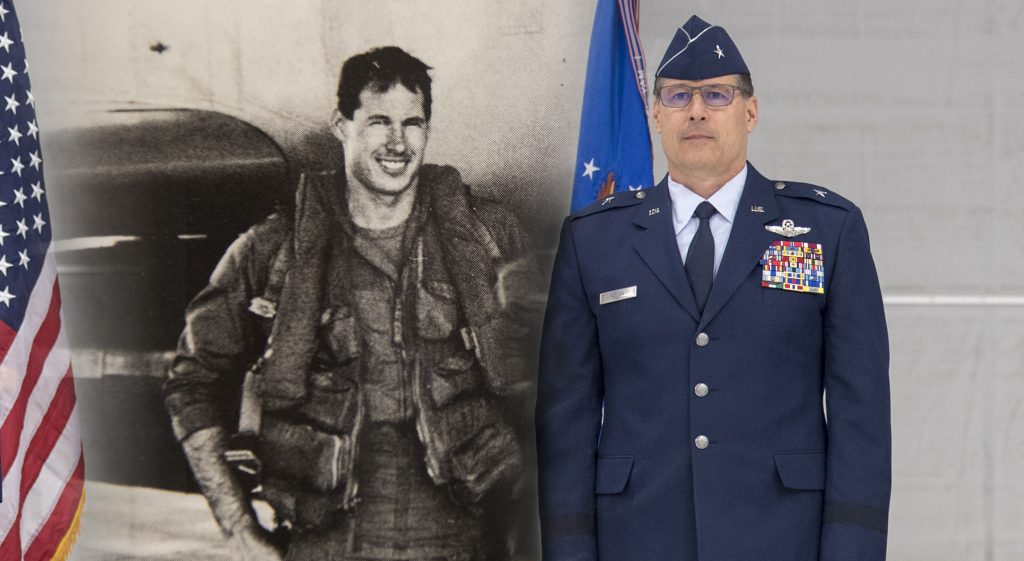
By Master Sgt. Becky Vanshur
Idaho Air National Guard
Gowen Field, Idaho – After nearly 35 years of service, Brig. Gen. Michael A. Nolan, former Assistant Adjutant General-Air, Idaho Air National Guard, retired at a ceremony at Gowen Field on July 17. As his career comes to an end, Nolan realizes the bond and experiences he shares with others are what is most important to him.
“It’s the people you work with every day that you have a common experience with,” said Nolan. “This shared experience brings you close to each other as a team. It brings out the best in each of us, we come together, and we share together. As I retire, I will now be on the outside of this, but I will still have that shared common experience with all of these great people.”
Nolan was previously the commander of the 124th Fighter Wing at Gowen Field and was a pilot, flying missions with the F-4E and F-4G Phantom II aircraft and the A-10 Thunderbolt II aircraft.
Before he joined the Idaho Air National Guard, Nolan was an F-4G pilot instructor in California and met several Idaho pilots there. He decided to turn down an active duty Air Force pilot bonus in October 1992 and seven days later he moved to Idaho to fly the F-4G assigned to the 190th Fighter Squadron.
“The best decision I ever made was to move here,” said Nolan. “My experience in the Guard has been remarkable and I felt really fortunate to be welcomed, to be given the opportunities I was given, and to be trusted.”
When Idaho’s mission changed in 1996, Nolan transitioned to an A-10 Thunderbolt II pilot. Although he flew F-4 missions, the A-10 mission was his passion.
“The Warthog is a phenomenal machine,” said Nolan. “The A-10 mission had much more of an impact on me than my other flying experiences.”
Five years ago, Nolan flew his last A-10 flight as the 124th Fighter Wing commander and was promoted to command the Idaho Air Guard.
Nolan said that one of his greatest leadership moments as the Assistant Adjutant General was being involved in ending the concept of moving the Idaho Air National Guard to Mountain Home Air Force Base and transitioning to the F-15E mission.
“The Strike Eagle at Mountain Home is an awesome mission; it just wasn’t for us as a local, community-based Guard unit,” said Nolan. “Parallel to keeping us in Boise, was the fight to keep and modernize our A-10s.”
To Nolan, his military career was about more than just flying the F-4 and A-10 missions.
“People join the military for various reasons, for me it was that I wanted to fly jets, but then once you’re in the military you realize that you are part of something that is much bigger than yourself,” said Nolan.
Two Idaho Guardsmen earn air assault badges
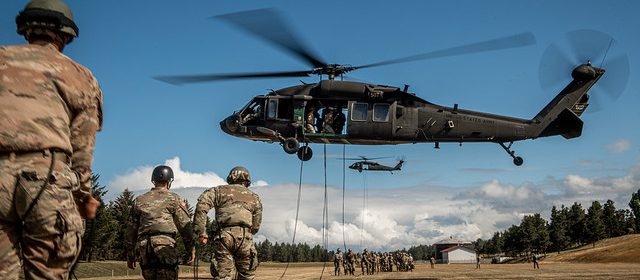
Capt. Robert Taylor
Idaho Army National Guard
Two Idaho National Guardsmen graduated from the U.S. Army’s Air Assault School June 28 at Camp Rilea, Oregon. Idaho Army National Guard Soldier Cadet Porter Haux and Idaho Air National Guard Airman Senior Airman Matthew McKee completed the 10-day course to earn their air assault badges.
In addition to completing air assault school, McKee also graduated from the Army’s Rappel Master Course July 3.
“They were both good courses,” McKee said. “It was a good experience.”
McKee, a tactical air control party specialist with the 124th Fighter Wing’s 124th Air Support Operations Squadron, spent eight years in the Army Reserve before joining the Idaho Air National Guard in January 2018.
He becomes the unit’s third rappel master, which gives the squadron the required number of qualified airmen to conduct its own rappel training. The unit plans to train with the Idaho Army National Guard’s 1-183rd Assault Helicopter Battalion, which flies UH-60 Black Hawks.
The battalion’s Black Hawks supported the training courses, which included the Army’s Pathfinder Course.
Haux, a junior in Boise State University’s ROTC program, said he attended the course to become a better Soldier.
“I figured air assault course was something that I could do to better myself and further my career while doing something few people learn how to do,” he said. “I got paid to learn how to rappel from a helicopter, which is something people probably would pay a lot of money to learn how to do.”
Haux has served in the Idaho Army National Guard since November 2017. His father, Maj. Kelly Haux, is an active duty officer.
“It’s been my dream to be a Solider since I was capable of dreaming,” Haux said. “I always wanted to be a Soldier like my dad.”
The air assault course featured 10 days of instruction in three phases; combat assault operations, sling load operations and rappelling.
In phase one Soldiers and Airmen received training on combat assault, aircraft orientation, aircraft safety, aeromedical evacuation, pathfinder operations and hand and arm signals. In phase two they learned to prepare, rig and inspect various military sling-loads for equipment and vehicles such as the M998 HMMWV and M1102 Cargo Trailer. In the final phase Soldiers received instruction on tying a rappel seat, hook-up techniques, lock-in procedures, belay procedures and rappelling.
Throughout training students received several written and performance-oriented tests, conducted multiple runs and foot marches and rappelled from multiple towers and rotary wing aircraft.
Towards the end of the course, Soldiers demonstrated what they learned while repelling from a Black Hawk 90 feet above the ground.
Back to Newsroom
Join the Idaho Air National Guard
Invaluable training for Idaho TACPs
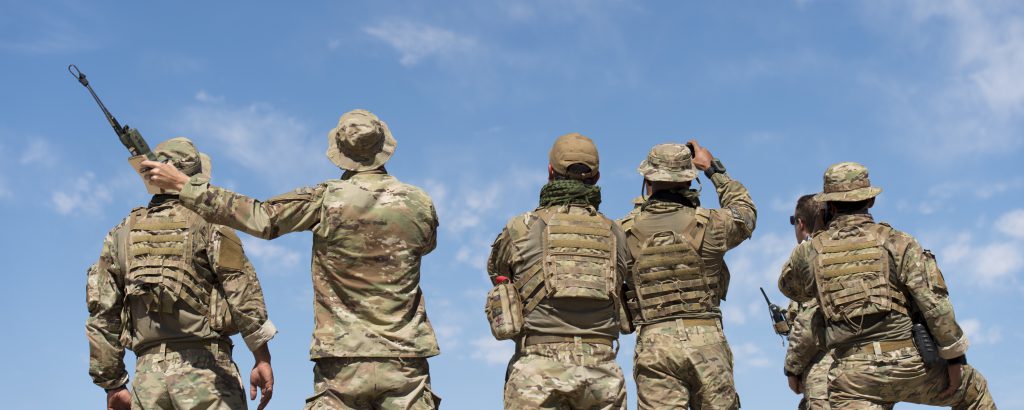
FORT IRWIN, CA, UNITED STATES
06.18.2019
Story by Senior Airman Mercedee Wilds
It’s a brutal 104 degrees before noon, and an Idaho Air National Guard tactical air control party Airman stands under netting for protection from the scorching sun, watching for the opposing force and listening for the buzz of a rattle snake.
He is surrounded by joint terminal attack controllers from the Brazilian Air Force and Soldiers from the 116th Cavalry Combat Brigade Team, Idaho Army National Guard, preparing and planning for their next move.
It’s been two long weeks since anyone has had a shower or an actual bed to sleep in, but the training mission at the National Training Center in Fort Irwin, California, must go on.
During the 116th Cavs’ rotation at the NTC – running 24-hour operations May 24 through June 20, 2019 – the 124th Air Support Operations Squadron TACPs were able to embed and practice calling in close air support from the 190th Fighter Squadron’s A-10 Thunderbolt IIs for the Soldiers on the ground.
NTC is deep in the Mojave Desert and has dozens of simulated villages, firing ranges and rough terrain, preparing the U.S. military for future deployments.
The large-scale exercises gave members of the 124th ASOS the opportunity to work with thousands of Soldiers, and dozens of their international JTAC counterparts as they experienced the confusion, chaos and fog of war, and were still able to accomplish the mission at hand.
The training that the Idaho National Guard Soldiers and Airmen received at NTC was invaluable and impossible to replicate back at their home station in Boise, Idaho.
Back to Newsroom
Join the Idaho Air National Guard
Get your gun out, get rounds down range
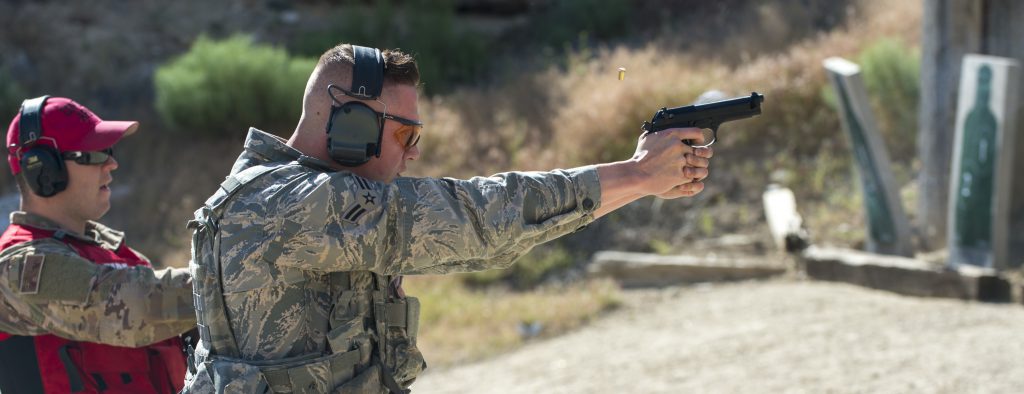
BOISE, ID, UNITED STATES
06.19.2019
Story by Ryan White
Members of the 124th Security Forces Squadron, Idaho Air National Guard and the 173rd SFS, Oregon Air National Guard, participated in a brand new combat arms training course June 19, 2019, Gowen Field off-base range, Boise, Idaho. The training was part of a biennial joint SF field training exercise with the IDANG and ORANG.
The Air Force requires Security Forces members to participate in a live fire exercise every quarter, including qualifying on the M-9 every year. This quarter’s live fire was a newly designed course focused on reactionary and instinctive shooting techniques.
“All of our shop came together and threw out ideas, and I’m impressed with how much work the shop as a whole put in to building this course of fire—table toping it, live firing it and giving their suggestions,” said Master Sgt. Mikel Turner, NCO in charge, Combat Arms Training and Maintenance, 124th SFS. “What we normally do is more of a marksmanship. It teaches you how to hold the gun, how to aim the gun, how to control your breath, all the fundamentals that are involved with shooting. With this, those don’t play such an important role. It’s more of a get your gun out and get rounds down range before something bad happens to you.”
In the new course, airmen practiced shooting at close range and quickly rescuing a simulated casualty while returning fire. It was a race against the clock to see who could move the quickest and most efficiently.
Typically, Airmen have to hit a certain number of rounds on target which are then scored to see if they get a qualification, pass or expert. With this training it was all for practice and familiarity to help Airmen confidently rely on their weapons. The goal was to give them an idea of how their weapons would perform during a real-world scenario.
“They come away from the line with eyes wide, saying, ‘I didn’t know I could do that; I didn’t know the pistol could do that,’” said Tuner.
Combat Arms plans to do more courses like this in the future to fulfill their quarterly live fire requirements. Turner says, they plan to switch up future scenarios, based on the feedback of participants and instructors, to help ensure the best training possible.
Back to Newsroom Join the Idaho Air National GuardGrounded: Idaho pilots land to work with Idaho Soldiers
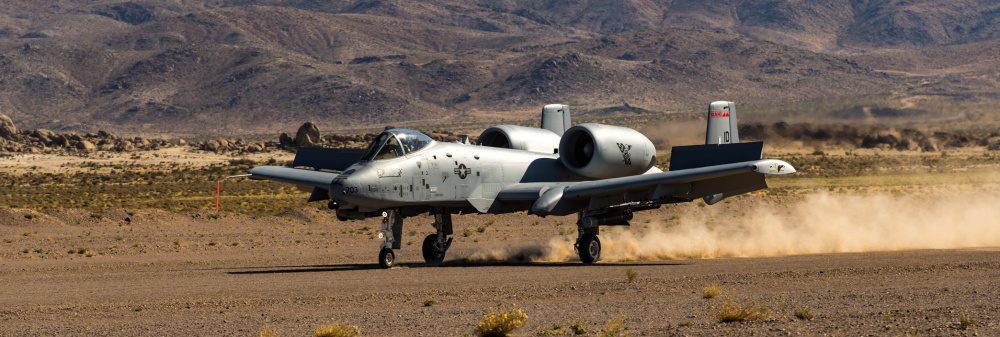
FORT IRWIN, CA, UNITED STATES
06.08.2019
Story by Capt. Robert Taylor
During combat operations, there’s no substitute for the ability to talk face-to-face with a supporting unit. For pilots from the 124th Fighter Wing’s 190th Fighter Squadron, this means landing their A-10 Thunderbolt IIs in a dry lake bed to discuss current operations with the 116th Cavalry Brigade Combat Team’s air liaison officer while supporting the brigade’s National Training Center rotation at Fort Irwin, California, June 4 – 9.
“We can talk about the latest conditions on the battlefield,” said 124th Air Support Operations Squadron Maj. Johnny Reyes, the brigade’s air liaison officer. “They can get the latest update on the commander’s intent for use of close air support.”
The Idaho Air National Guard’s 190th Fighter Squadron is supporting the 116th CBCT’s month-long NTC rotation through its participation in Green Flag-West 19-8, a realistic air-land integration combat training exercise. Pilots launch out of Nellis Air Force Base in Las Vegas to provide close air support to the 116th CBCT in the brigade’s fight against opposing forces provided by the U.S. Army’s 11th Armored Cavalry Regiment.
Pilots spent the week completing qualification landings on the NTC’s Freedom Landing Strip to be prepared to land in austere environments in a combat environment.
“The training gives us confidence we can do it in a combat situation if required,” said Lt. Col. “Champ” Clark, 190th Fighter Squadron commander.
Landing in austere conditions is a task the A-10 Thunderbolt II is well designed for, Clark said. The aircraft’s twin engines are placed high on the aircraft, minimizing the risk the engines could be damaged during landing. Its tires are wide and rugged. Its high ground clearance assists with landing on less-then-ideal surfaces.
“It’s the same as landing on a paved runway, but different,” Clark said. “You have to ensure you land soft and you can’t really break as much as you’d like to. The runway is a little rougher. It’s a little more challenging, so you have to be more careful.”
Once pilots land, they have the ability to communicate directly with Soldiers and Airmen on the ground, including the unit’s air liaison officer, the ground force commanders and their staffs.
Reyes, and the 190th ASOS, is aligned with the 116th CBCT. Because the 124th Fighter Wing’s and the 116th CBCT’s headquarters are located less than a mile apart on Gowen Field in Boise, Reyes is able to fully integrate into the brigade’s staff. Reyes and the unit’s joint terminal attack controllers deploy anywhere the 116th CBCT does to coordinate the use of close air support to support the brigade’s deep fight. The 190th Fighter Squadron’s participation in Green Flag-West happened to coincide with the brigade’s NTC rotation.
“It’s really cool to work with Idaho Army National Guard Soldiers,” Clark said. “Those relationships we build at home, we continue out here and take back with us.”
Rayes said it would tie up brigade communication channels for a significant period of time to communicate all of the latest updates to pilots in the sky. In addition, pilots are able to offer updates to the unit’s maps based off what they saw on their way to the brigade’s tactical operations center, which helps improves the brigade’s common operating picture.
“Pilots serve as an extension of the tactical air control party and get a lot of work done in the deep fight,” Reyes said.
The 116th CBCT’s tactical air control party consists of Reyes, more than a dozen 190th ASOS JTACs, two Marine JTACs and five members of the Brazilian Special Operations Command.
The 116th CBCT, is comprised of 3,000 Soldiers, including 1,800 from 137 Idaho communities and 1,200 Soldiers from the Montana, Nevada and Oregon Army National Guards. The unit is completing a month-long rotation at the National Training Center to build combat readiness and improve Soldier proficiency in their wartime missions. More than an additional 1,000 Soldiers from units in nine Army National Guard states are supporting the 116th CBCT’s rotation. The 116th CBCT is one of five National Guard armored brigade combat teams.
Viva Las Vegas – The 124th Fighter Wing Arrives at Green Flag-West

LAS VEGAS, NV, UNITED STATES
06.02.2019
Story by Master Sgt. Joshua Allmaras
More than 190 Airmen from the 124th Fighter Wing, Boise, Idaho and 12 A-10 Thunderbolt II aircraft from the 190th Fighter Squadron arrived at Nellis Air Force Base, Nevada, May 30, 2019.
The aircraft and Airmen are participating in Green Flag-West 19-8, a realistic air-land integration combat training exercise. This exercise will heavily support the Idaho Army National Guard’s 116th Cavalry Brigade Combat Team, who are training at the Fort Irwin National Training Center in California in preparation for an overseas deployment.
“This training is invaluable to our pilots, maintenance and support Airmen,” said Col. Shannon Smith, the 124th Fighter Wing commander. “It allows us the opportunity to hone our close air support skills, validate joint interoperability and achieve combat readiness.”
Not only is this training valuable to the wing, but it directly supports our fellow guardsmen.
“We not only will be enhancing our combat lethality, but we will directly be supporting our fellow guardsmen in the Idaho Army National Guard during our Green Flag rotation,” said Smith. “Nothing hits home more than knowing you are directly supporting your fellow brothers and sisters from the Idaho National Guard.”
Out of the 3,000 soldiers that comprise the 116th CBCT, more than 1,800 are from 137 Idaho communities. The training is key to the success of the soldiers.
“The national training center provides some of the most realistic training the Army has to offer,” said Col. Scott Sheridian, the 116th CBCT commander. “This gives us the opportunity to exercise our warfighting functions in a way we can’t anywhere else.”
This Army deployment is the largest in the 116th CBCTs history, but that’s not the only first.
“From what I understand, this is the first time that both an air and land component from the same state have supported each other in both the Green Flag and NTC training environment,” said Smith. “This is one of those unique opportunities to directly and positively impact the overall combat readiness of the entire Idaho National Guard.”
ACC Commander visits IDANG
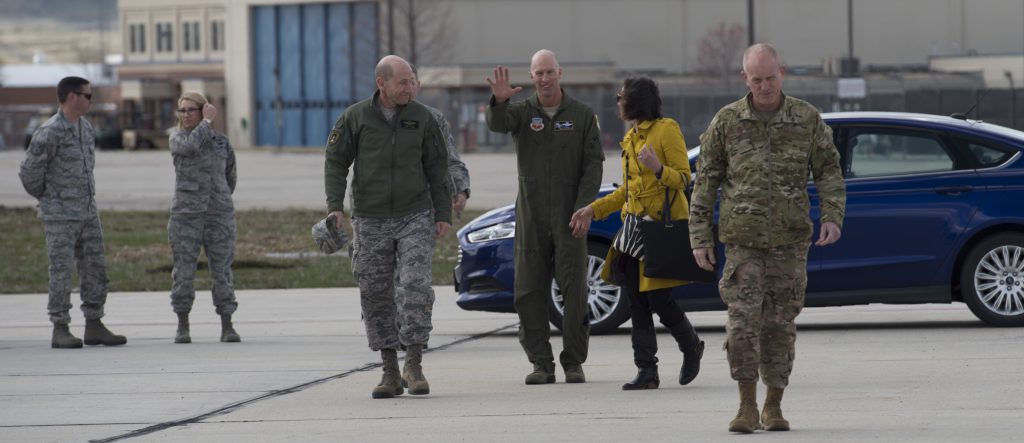
BOISE, ID, UNITED STATES
03.28.2019
Story by Airman 1st Class Mercedee Wilds
124th Fighter Wing
Gen. Mike Holmes, commander of Air Combat Command, visited Airmen from the Idaho Air National Guard while on a tour of multiple installations, March 28, 2019, at Gowen Field in Boise, Idaho.
Holmes said the focus of the Air National Guard aligns with his primary goals, which include revitalizing squadron readiness, developing leaders and reaching the future faster. In addition to revitalizing weapons systems, increasing the readiness of Airmen and their families is Holmes’ top priority.
When it comes to selecting leaders, Holmes looks for individuals who are ready to win in a joint mission environment, which is an area the Guard excels in.
“There is an environment in the ANG that gives Airmen the opportunity to learn, develop and take on leadership,” said Holmes.
He said a leader is someone who can guide the team they’ve been given and accomplish their mission within their resources and with the Air Force’s core values top of mind.
“The ANG does a great job of preparing and presenting leaders,” said Holmes.
Holmes said he is focusing on removing red tape and delays that stop the total force from modernizing. “My wish for everybody in the Air Force and ANGis that they find a life that gives them meaning and purpose,” said Holmes. “I hope that the time they spend wearing the uniform contributes to that.”
Back to Newsroom
Join the Idaho Air National Guard
 Official Government Website
Official Government Website